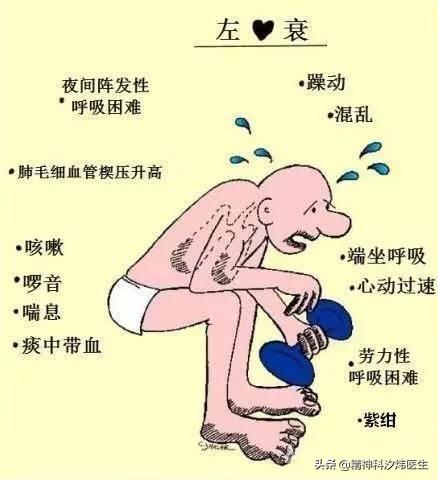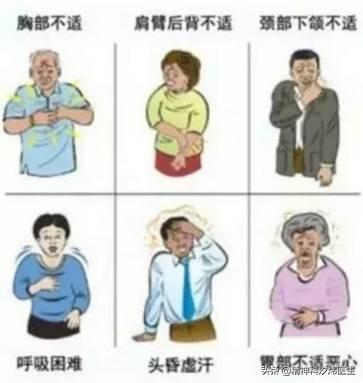What is the difference between heart attack and heart failure?
What is the difference between heart attack and heart failure?
What is the difference between heart attack and heart failure?

Heart failure is an occlusive narrowing of the blood vessels on the basis of a heart attack and cardiac insufficiency. However, heart failure can be combined with heart attack at the same time. Simply put, heart attack is caused by the blockage of coronary arteries, resulting in a decrease in blood supply to the heart muscle, causing myocardial necrosis, and ultimately the clinical symptoms of ischemia and hypoxia. Heart failure, on the other hand, is a condition in which the heart does not beat as vigorously as it normally does, resulting in decreased ejection of blood from the heart, and ultimately stagnation of the lungs and the circulation.To say what is the difference between heart failure and heart attack.
1. to look at their primary pathology myocardial infarction is due to coronary artery ischemia stenosis, hypoxia necrosis will form thrombus rupture lead to vascular wall occlusion, heart failure is due to long-term heart valve disease hypertension myocarditis, cardiomyopathy, arrhythmias lead to compensatory hypertrophy of the heart, coupled with functional changes in the heart caused by long-term high blood pressure.
2. In terms of clinical manifestations, the symptoms of heart attack are mainly pain (there may be pain in the precordial region, radiating to the back, neck, etc.), while heart failure is what we usually call heart failure, which is characterized by limited activity, dyspnea, weakness, fatigue, and there may be symptoms of pulmonary stasis. There may also be edema and liver enlargement on examination. We often see that people with heart failure are out of breath and have decreased endurance when they go upstairs, all of which indicates that the patient is underperfused.
3. In addition to the difference between them, some people may myocardial infarction due to ischemia and hypoxia will also cause a decline in cardiac function, induced heart failure, so that they sometimes have new blood vessels under a certain degree of heart failure, where occlusion also induces a new foci, the emergence of acute myocardial infarction may be a concurrent or complementary to the occurrence of a disease.
4,Whether it is heart failure or heart attack, the principle of treatment is also different, so that need to be based on the typical clinical symptoms as well as the onset of the situation and important signs. Combined with laboratory indicators and auxiliary examination, symptomatic treatment is effective, heart failure treatment most of the advocates to improve myocardial metabolism, nutritional myocardium, improve myocardial function, correct the new function, cardiotonic diuretic vasodilatation, infarction treatment is the treatment of the primary pathology, alleviate the ischemia and hypoxia, dilate the arteries anti-coagulation and anti-thrombosis if necessary, need to select the appropriate drugs according to the condition as well as the interventional surgical treatment.
Heart failure and heart attack is a common disease in cardiology, most of them are disability rate, death rate is relatively high, and long-term repeated hospitalization, may cause the patient psychophysiology will be anxious and depressed state, many people will be on the disease of self-loathing, so that in addition to drug therapy as well as standardization, treatment of the primary disease needs to be channeled to the psychotherapy, inform the patient of the disease to have an understanding of the disease, to improve the disease's Cure rate, knowledge rate, death rate.
The difference between heart attack and heart failure is still relatively obvious, heart attack mainly refers to the heart of the blood vessel atherosclerosis, and lead to the narrowing of the blood vessel, if in the narrowing of the basis of acute occlusion of the blood vessel, will cause by this blood vessel to supply blood to the myocardium to occur in acute ischemia, and ultimately lead to necrosis of the myocardium, general infarction area is relatively small, the number of necrotic myocardium is relatively small, it is not easy to cause heart failure. If the infarction area is large and the number of necrotic myocardium is large, the number of myocardium involved in cardiac contraction will be significantly reduced, which will cause heart failure. And there are other causes of heart failure in addition to the causes of infarction, the most common causes such as mitral valve closure insufficiency, aortic valve closure insufficiency and other heart valve diseases, acute fulminant myocarditis caused by damage to the myocardium, and primary myocardial diseases such as dilated cardiomyopathy can cause heart failure, which emphasizes the heart's reduced ejection capacity.
What is the difference between heart attack and heart failure?
Heart attack is a kind of coronary heart disease, belongs to an independent disease, which is secondary to the atherosclerosis of the coronary artery, on the basis of coronary artery lesions, certain triggers will lead to the blockage of coronary artery, ischemic necrosis of cardiomyocytes, resulting in a series of post-sternal or precordial pain, lasting for a few hours, the ineffectiveness of nitroglycerine under the tongue, sweating and so on, as the main manifestations of the independent disease.
Heart failure is not a stand-alone disease; it is a description of the functional state of the heart and is an inevitable consequence of all cardiogenic diseases that continue to develop to a certain extent. Heart failure includes right heart failure, left heart failure, and total heart failure, and can present clinically with a range of symptoms such as decreased activity tolerance, shortness of breath, lower extremity edema, significant liver, jugular vein rage, and facial swelling.
Heart failure can be secondary to infarction, or secondary to other diseases, such as rheumatic heart disease, hypertensive heart disease, congenital heart disease and other cardiac diseases; infarction, if the scope of the lesion is wider, the cardiac function is seriously impaired, the patient can be combined with the heart failure; on the contrary, if the lesion is more confined, the cardiac function is less affected, the patient can also not appear heart failure.
In summary, heart attack is a separate disease, whereas heart failure is a state of cardiac function that occurs when cardiogenic disease persists to a certain degree.

The difference between heart attack and heart failure is relatively obvious. Heart attack mainly refers to the occurrence of atherosclerosis in the blood vessels of the heart, which leads to the narrowing of the blood vessels. If an acute occlusion of the blood vessels occurs on top of the narrowing, acute ischemia of the myocardium supplied with blood by this blood vessel will occur, which ultimately leads to myocardial necrosis, and the heart will not be able to recover from this ischemia.
Usually the infarct is relatively small and the amount of necrotic myocardium is relatively small, it is less likely to cause heart failure. If the infarct is large and the amount of necrotic myocardium is large, the amount of myocardium involved in the contraction of the heart will be significantly reduced, and heart failure will result.
And there are other causes of heart failure besides the causes of heart attack, the most common causes such as mitral valve closure insufficiency, aortic valve closure insufficiency and other heart valve diseases, acute fulminant myocarditis causing damage to the myocardium, and primary myocardial diseases such as dilated cardiomyopathy can cause heart failure, which emphasizes on the reduced ejection capacity of the heart.
The difference between heart failure and myocardial infarction is as follows:
1, heart failure: due to various factors damage to the myocardium, resulting in abnormal heart structure and function, mainly manifested as myocardial systolic hypoplasia, diastolic hypoplasia or diastolic filling disorder, resulting in the heart pumping out blood is not enough to meet the body's tissue metabolism needs, thus producing a clinical syndrome;
2, myocardial infarction: specifically refers to bleeding caused by coronary atherosclerotic plaque rupture, secondary thrombosis, causing coronary artery blockage.
Myocardial infarction is a major cause of heart failure, and acute phase myocardial infarction can present with acute heart failure due to extensive loss of myocardial function. An old myocardial infarction can also be caused by myocardial infarction with left ventricular remodeling, which manifests itself as diminished or absent motion or even paradoxical motion in the infarcted area.
Patients with compensatory thickening of the myocardium in non-infarcted areas can also suffer from heart failure, in addition to vascular causes of heart failure, as well as hypertension, which causes heart failure due to increased cardiac load. Thus, heart failure is the result of the end stage of various heart diseases, and myocardial infarction is the clinical process of myocardial necrosis due to cardiovascular disease.
Heart attack and heart failure are two different diseases occurring in the heart, with different etiologies, different clinical signs and symptoms and auxiliary findings, and different treatments.
Heart attack occurs due to atherosclerosis, the blood vessels supplying the heart muscle, i.e. myocardium, are blocked, resulting in myocardial ischemia or even necrosis. The main clinical manifestations are chest tightness and chest pain, arrhythmia, mild symptoms can be effective after thrombolysis and other treatments, but severe cases can lead to sudden death. The electrocardiogram shows infarction, and the blood test shows changes in myocardial enzyme spectrum.
There are many causes of heart failure, including coronary artery disease (CAD), chronic obstructive pulmonary disease (COPD), severe hypertension, hypertrophic cardiomyopathy, severe arrhythmia, fulminant myocarditis, sepsis, and so on, all of which can lead to heart failure. Heart failure can be categorized into acute heart failure and chronic cardiac insufficiency. It can be categorized into left heart failure, right heart failure, and total heart failure, and according to the severity, it can be categorized into different grades of cardiac insufficiency. The main manifestations include chest tightness, dyspnea, inability to lie down, swelling of the lower extremities, and shortness of breath that worsens with activity. Severe heart failure and acute heart failure can lead to sudden death if not treated in time. The treatment of heart failure is mainly to remove the cause of the disease, cardiotonic diuretic, reduce the heart load. Electrocardiograms and blood tests show the corresponding results of heart failure.
Relationship between heart attack and heart failure: heart attack can cause heart failure and heart failure can aggravate heart attack.
Heart attack is the heart hidden activity caused by the disorder disease and heart labor is: long-term overwork fatigue excessive fatigue caused by the heart blood deficiency disease, I hope that we can seriously study the theoretical knowledge of the division of clear on the evidence of the treatment is too good.
This question and answer are from the site users, does not represent the position of the site, such as infringement, please contact the administrator to delete.